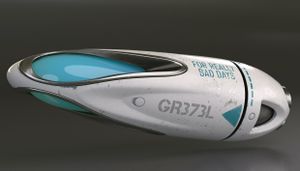
The ALR-1 "Ravis" Missile is the finalized version of the previous experimental ALR-X Missile. The new design takes a radically different philosophy to the ALR-X model. This missile is shorter and carries a smaller matter-antimatter payload. Still designed to be fired autonomously the missile focuses on stealth rather than explosive yield.
- Size
- 57 Meters Long
- Payload
- 1250 kg of matter/antimatter
- Explosive Yield
- 26 Gigatons TNT Maximum
- Max Speed
- Warp 9.975
- Cruising Speed
- Warp 9.25
- Range
- 250 ly
Onboard Computer
The missile uses a modified ALICE system to facilitate access and complete its mission. Since the ALICE Interface is not sentient it guarantees the missile will follow its programming. The interface also facilitates ease of programming and has built in safeguards to defend against unwanted friendly fire. The safety controls now engage if the explosive yield has a high probability of causing significant damage to friendly vessels. In a situation where this can be detected in advance, the missile can send a single data burst asking for instructions back to it's launch point and can even auto-adjust its own yield. This is called the yield failsafe.
This yield failsafe mechanism is also where the weapon gets its name. The ALR-X was not test detonated in actual combat except for when Tal Ravis detonated the weapon in fighting an invasion force attacking the Schatten Star System. The yield of the weapon was set for maximum when this level of explosion was not only unnecessary but would also go on to destroy not only the target but over half of the Umbral Shipyards and several other Solas Tempus vessels. As such the yield failsafe is often also called the Ravis failsafe after the person who detonated the ALR-X weapon in combat.
Drive System
The warp drive system employs a single warp coil in the center and a second smaller coil at the rear. These two coils work in tandem and their design significantly reduces the warp image and plasma trail of the weapon. The rear coil also acts as a driver coil for sub-light travel.
Weapon Deployment
When the weapon is launched it has multiple phases of operation which dictate it's behavior.
- Phase 1
- Launch phase, the weapon obtains a lock on its destination and plots the appropriate course taking in factors to avoid detection. Course is plotted to make a series of random adjustments along the flight path.
- Phase 2
- Tracking phase, the weapon switches sensors into passive mode during flight. At random intervals during flight the weapon will periodically drop out of warp in an area with no other traffic detected and establish target lock. At this time it will also update its information via BlueNet.
- Phase 3
- Locking phase, when the weapon gets within 1 lightyear of its target it will engage cloak and switch its communication and sensors to passive-only to avoid detection. At this point the weapon cannot be disarmed unless a direct subspace transmission is received from a source within sensor range which can be authenticated.
- Phase 4
- Final phase, when the weapon reaches a range of 150 km from the target it will drop out of warp and remain cloaked. Once at sublight speed it will plot an erratic course to the target at the optimal speed to avoid detection. During this phase the weapon cannot be disarmed except if its yield failsafe is triggered where it will change to Phase 3 with the exception that it will stay within range of target.
Once in Phase 4 the weapon will make its way to the target and detonate. The weapon can be programmed to detonate at a specific range from target, time of day, or other such parameters. It can also be programmed to detonate on impact.
Defensive Systems
- Deflector Shields
- Ablative Hull Armor
- Cloaking Device
Offensive Systems
- Plasma Bolt Launchers (1 Forward / 1 Aft)
- Phaser Emitter (1 Forward)
- Micro Torpedo Launcher (1 Aft)